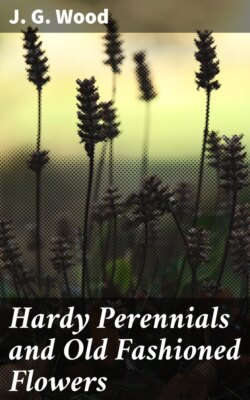Читать книгу Hardy Perennials and Old Fashioned Flowers - J. G. Wood - Страница 41
На сайте Литреса книга снята с продажи.
Bellis Perennis.
ОглавлениеTable of Contents
Common Perennial Daisy; Nat. Ord. Compositæ.
This native plant, the commonest flower of the field and wayside, and the weed of our grass-plots, is the parent form of the handsome and popular double kinds seen in almost every garden. Well known as these flowers are, it may prove interesting to learn a little more about the fine large double crimson and white kinds—their treatment, for instance—in order to have abundance of flowers during the earliest months of the year; and the uses to which they may be most advantageously put; for, common as are the Daisies, they are, without doubt, amongst the most useful flowers we possess. First, I will briefly give the names and descriptions of the more distinct varieties.
B. p. aucubifolia is the Double Daisy, having a beautifully variegated foliage, mottled with golden-yellow in the way of the aucuba.
B. p. fistulosa.—This is the double crimson or pink Daisy, having its florets piped or quilled (see Fig. 19).
B. p. hortensis embraces all the double forms raised and cultivated in gardens, no matter what colour, and so distinguished from the typical form of the fields.
B. p. prolifera is that curious and favourite kind called "Hen and Chickens." The flowers are double, and from the imbricate calyx of the normal flower there issue a number of smaller Daisies having straggling florets; the whole on one main stalk presenting a bouquet-like effect.
These kinds, the specific names of which are not only descriptive, but amply embrace the group, are much added to by flowers having other names and minor distinctions, the latter, for the most part, being only shades or mixtures of colour—as crimson, pink, white, and bicolours. The florets in many kinds are exceedingly pretty, from the way in which they are tipped and shaded; notably, a new variety that was sent me under the name of Dresden China. These sorts having different tints are usefully named with "florists'" names—as Pearl, Snowball, Rob Roy, Sweep, Bride, &c. I may say that I have long grown the Daisy largely, Bride and Sweep being the favourite kinds; both are robust growers, very hardy and early. Bride is the purest white, with florets full, shining, and well reflexed; rather larger than a florin, and when fully developed has a half globular appearance; another good point is its flower stalks being 4in. to 5in. long, which renders it serviceable as cut bloom. Sweep is not quite so large, though a good-sized Daisy, it also opens more flat; its colour, however, is first rate, it is the darkest crimson Daisy I ever saw, is of a quilled form and very full. Its chief point is its constant colour; if the florets are examined, they are the same deep crimson underneath as on the face of the flower; this, together with its long stalks, renders it useful, too, in a cut state.
Fig. 19. Bellis Perennis Fistulosa. (One-third natural size.)
To grow this useful flower well and render it doubly valuable by having it in bloom in mid-winter, requires three things: First, timely transplanting; secondly, rich soil; thirdly, partial shade; these conditions will be more briefly and, perhaps, clearly explained, if I state my method. At the end of May or fore part of June, plenty of good rotten stable manure is wheeled into the bush-fruit quarters; it is worked in with a fork, so as to do as little damage as possible to the bush roots. A line is drawn, and the old Daisy roots which have just been taken up are trimmed by shortening both tops and roots. They are severely divided, and the pieces planted 6in. apart in rows 8in. asunder. In such a cool, moist situation they soon form good tufts, and I need scarcely say that the dressing of manure has also a marked effect on the fruit crop. A planting so made is not only a cheerful carpet of greenery during winter, but is well dotted over with bloom. The plants being well established in rich soil, and having the shelter of the bushes during summer and winter, are the conditions which have conduced to such early flowers. This is the method I have adopted for years, and both Daisies and fruit have been invariably good crops. I ought, however, to say that beds more exposed, together with the fact that the Daisy roots have to be transplanted in October or November, never flower so early, from which it will be seen that the treatment explained hardly applies to such bedding; but where a breadth of bloom is required, say, for cutting purposes, I know no better plan. As cut bloom the daisy is charming in glass trays on a bed of moss, or even in small bouquets, mixed with the foliage of pinks, carnations, and rosemary. Such an arrangement has at least the merit of sweet simplicity, and somehow has also the effect of carrying our thoughts with a bound to spring-time.
The ancient names for this "old-fashioned" flower were "Little Daisies" and "Bruisewoorte." The latter name, according to Gerarde, was applied for the following reasons: "The leaues stamped, taketh away bruses and swellings proceeding of some stroke, if they be stamped and laide thereon, whereupon it was called in olde time Bruisewoorte. The iuice put into the eies cleereth them, and taketh away the watering;" and here is a dog note: "The same given to little dogs with milke, keepeth them from growing great."
Flowering period, February to July.
